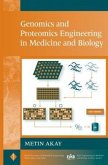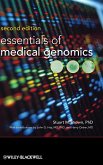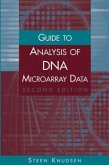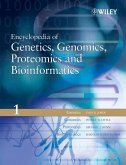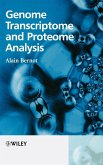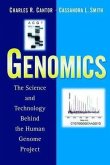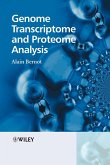Data Analysis and Visualization in Genomics and Proteomics
Ed. by Francisco Azuaje and Joaquin Dopazo
Data Analysis and Visualization in Genomics and Proteomics
Ed. by Francisco Azuaje and Joaquin Dopazo
- Gebundenes Buch
- Merkliste
- Auf die Merkliste
- Bewerten Bewerten
- Teilen
- Produkt teilen
- Produkterinnerung
- Produkterinnerung
Data Analysis and Visualization in Genomics and Proteomics is the first book addressing integrative data analysis and visualization in this field. It addresses important techniques for the interpretation of data originating from multiple sources, encoded in different formats or protocols, and processed by multiple systems. _ One of the first systematic overviews of the problem of biological data integration using computational approaches _ This book provides scientists and students with the basis for the development and application of integrative computational methods to analyse biological…mehr
Andere Kunden interessierten sich auch für
![Genomics and Proteomics Engineering in Medicine and Biology Genomics and Proteomics Engineering in Medicine and Biology]() Metin Akay (ed.)Genomics and Proteomics Engineering in Medicine and Biology159,99 €
Metin Akay (ed.)Genomics and Proteomics Engineering in Medicine and Biology159,99 €![Essentials of Medical Genomics Essentials of Medical Genomics]() Stuart M. BrownEssentials of Medical Genomics126,99 €
Stuart M. BrownEssentials of Medical Genomics126,99 €![Guide to Analysis of DNA Microarray Data Guide to Analysis of DNA Microarray Data]() Steen KnudsenGuide to Analysis of DNA Microarray Data97,99 €
Steen KnudsenGuide to Analysis of DNA Microarray Data97,99 €![Encyclopedia of Genetics, Genomics, Proteomics and Bioinformatics, 8 Volume Set Encyclopedia of Genetics, Genomics, Proteomics and Bioinformatics, 8 Volume Set]() Dunn, Michael J.Jorde, Lynn B. / Peter F. R. Little / Shankar Subramaniam (Hgg.)Encyclopedia of Genetics, Genomics, Proteomics and Bioinformatics, 8 Volume Set2.847,99 €
Dunn, Michael J.Jorde, Lynn B. / Peter F. R. Little / Shankar Subramaniam (Hgg.)Encyclopedia of Genetics, Genomics, Proteomics and Bioinformatics, 8 Volume Set2.847,99 €![Genome Transcriptome and Proteome Analysis Genome Transcriptome and Proteome Analysis]() Alain BernotGenome Transcriptome and Proteome Analysis225,99 €
Alain BernotGenome Transcriptome and Proteome Analysis225,99 €![Genomics Genomics]() Charles R. CantorGenomics239,99 €
Charles R. CantorGenomics239,99 €![Genome, Transcriptome and Proteome Analysis Genome, Transcriptome and Proteome Analysis]() Alain BernotGenome, Transcriptome and Proteome Analysis91,99 €
Alain BernotGenome, Transcriptome and Proteome Analysis91,99 €-
-
-
Data Analysis and Visualization in Genomics and Proteomics is the first book addressing integrative data analysis and visualization in this field. It addresses important techniques for the interpretation of data originating from multiple sources, encoded in different formats or protocols, and processed by multiple systems.
_ One of the first systematic overviews of the problem of biological data integration using computational approaches
_ This book provides scientists and students with the basis for the development and application of integrative computational methods to analyse biological data on a systemic scale
_ Places emphasis on the processing of multiple data and knowledge resources, and the combination of different models and systems
_ One of the first systematic overviews of the problem of biological data integration using computational approaches
_ This book provides scientists and students with the basis for the development and application of integrative computational methods to analyse biological data on a systemic scale
_ Places emphasis on the processing of multiple data and knowledge resources, and the combination of different models and systems
Produktdetails
- Produktdetails
- Verlag: Wiley & Sons
- 1. Auflage
- Seitenzahl: 284
- Erscheinungstermin: 29. April 2005
- Englisch
- Abmessung: 250mm x 175mm x 20mm
- Gewicht: 680g
- ISBN-13: 9780470094396
- ISBN-10: 0470094397
- Artikelnr.: 13480485
- Herstellerkennzeichnung
- Libri GmbH
- Europaallee 1
- 36244 Bad Hersfeld
- gpsr@libri.de
- Verlag: Wiley & Sons
- 1. Auflage
- Seitenzahl: 284
- Erscheinungstermin: 29. April 2005
- Englisch
- Abmessung: 250mm x 175mm x 20mm
- Gewicht: 680g
- ISBN-13: 9780470094396
- ISBN-10: 0470094397
- Artikelnr.: 13480485
- Herstellerkennzeichnung
- Libri GmbH
- Europaallee 1
- 36244 Bad Hersfeld
- gpsr@libri.de
Dr Francisco Azuaje, Faculty of Informatics, University of Ulster, Jordanstown, Northern Ireland. Dr.?Joaquin Dopazo, Head of Bioinformatics, Spanish National Cancer Centre, Madrid, Spain.
Preface.
List of Contributors.
SECTION I: INTRODUCTION - DATA DIVERSITY AND INTEGRATION.
1. Integrative Data Analysis and Visualization: Introduction to Critical
Problems, Goals and Challenges (Francisco Azuaje and Joaquín Dopazo).
1.1 Data Analysis and Visualization: An Integrative Approach.
1.2 Critical Design and Implementation Factors.
1.3 Overview of Contributions.
References.
2. Biological Databases: Infrastructure, Content and Integration (Allyson
L. Williams, Paul J. Kersey, Manuela Pruess and Rolf Apweiler).
2.1 Introduction.
2.2 Data Integration.
2.3 Review of Molecular Biology Databases.
2.4 Conclusion.
References.
3. Data and Predictive Model Integration: an Overview of Key Concepts,
Problems and Solutions (Francisco Azuaje, Joaquín Dopazo and Haiying Wang).
3.1 Integrative Data Analysis and Visualization: Motivation and Approaches.
3.2 Integrating Informational Views and Complexity for Understanding
Function.
3.3 Integrating Data Analysis Techniques for Supporting Functional
Analysis.
3.4 Final Remarks.
References.
SECTION II: INTEGRATIVE DATA MINING AND VISUALIZATION -EMPHASIS ON
COMBINATION OF MULTIPLE DATA TYPES.
4. Applications of Text Mining in Molecular Biology, from Name Recognition
to Protein Interaction Maps (Martin Krallinger and Alfonso Valencia).
4.1 Introduction.
4.2 Introduction to Text Mining and NLP.
4.3 Databases and Resources for Biomedical Text Mining.
4.4 Text Mining and Protein-Protein Interactions.
4.5 Other Text-Mining Applications in Genomics.
4.6 The Future of NLP in Biomedicine.
Acknowledgements.
References.
5. Protein Interaction Prediction by Integrating Genomic Features and
Protein Interaction Network Analysis (Long J. Lu, Yu Xia, Haiyuan Yu,
Alexander Rives, Haoxin Lu, Falk Schubert and Mark Gerstein).
5.1 Introduction.
5.2 Genomic Features in Protein Interaction Predictions.
5.3 Machine Learning on Protein-Protein Interactions.
5.4 The Missing Value Problem.
5.5 Network Analysis of Protein Interactions.
5.6 Discussion.
References.
6. Integration of Genomic and Phenotypic Data (Amanda Clare).
6.1 Phenotype.
6.2 Forward Genetics and QTL Analysis.
6.3 Reverse Genetics.
6.4 Prediction of Phenotype from Other Sources of Data.
6.5 Integrating Phenotype Data with Systems Biology.
6.6 Integration of Phenotype Data in Databases.
6.7 Conclusions.
References.
7. Ontologies and Functional Genomics (Fátima Al-Shahrour and Joaquín
Dopazo).
7.1 Information Mining in Genome-Wide Functional Analysis.
7.2 Sources of Information: Free Text Versus Curated Repositories.
7.3 Bio-Ontologies and the Gene Ontology in Functional Genomics.
7.4 Using GO to Translate the Results of Functional Genomic Experiments
into Biological Knowledge.
7.5 Statistical Approaches to Test Significant Biological Differences.
7.6 Using FatiGO to Find Significant Functional Associations in Clusters of
Genes.
7.7 Other Tools.
7.8 Examples of Functional Analysis of Clusters of Genes.
7.9 Future Prospects.
References.
8. The C. elegans Interactome: its Generation and Visualization (Alban
Chesnau and Claude Sardet).
8.1 Introduction.
8.2 The ORFeome: the first step toward the interactome of C. elegans.
8.3 Large-Scale High-Throughput Yeast Two-Hybrid Screens to Map the C.
elegans Protein-Protein Interaction (Interactome) Network: Technical
Aspects.
8.4 Visualization and Topology of Protein-Protein Interaction Networks.
8.5 Cross-Talk Between the C. elegans Interactome and other Large-Scale
Genomics and Post-Genomics Data Sets.
8.6 Conclusion: From Interactions to Therapies.
References.
SECTION III: INTEGRATIVE DATA MINING AND VISUALIZATION - EMPHASIS ON
COMBINATION OF MULTIPLE PREDICTION MODELS AND METHODS.
9. Integrated Approaches for Bioinformatic Data Analysis and Visualization
- Challenges, Opportunities and New Solutions (Steve R. Pettifer, James R.
Sinnott and Teresa K. Attwood).
9.1 Introduction.
9.2 Sequence Analysis Methods and Databases.
9.3 A View Through a Portal.
9.4 Problems with Monolithic Approaches: One Size Does Not Fit All.
9.5 A Toolkit View.
9.6 Challenges and Opportunities.
9.7 Extending the Desktop Metaphor.
9.8 Conclusions.
Acknowledgements.
References.
10. Advances in Cluster Analysis of Microarray Data (Qizheng Sheng, Yves
Moreau, Frank De Smet, Kathleen Marchal and Bart De Moor).
10.1 Introduction.
10.2 Some Preliminaries.
10.3 Hierarchical Clustering.
10.4 k-Means Clustering.
10.5 Self-Organizing Maps.
10.6 A Wish List for Clustering Algorithms.
10.7 The Self-Organizing Tree Algorithm.
10.8 Quality-Based Clustering Algorithms.
10.9 Mixture Models.
10.10 Biclustering Algorithms.
10.11 Assessing Cluster Quality.
10.12 Open Horizons.
References.
11. Unsupervised Machine Learning to Support Functional Characterization of
Genes: Emphasis on Cluster Description and Class Discovery (Olga G.
Troyanskaya).
11.1 Functional Genomics: Goals and Data Sources.
11.2 Functional Annotation by Unsupervised Analysis of Gene Expression
Microarray Data.
11.3 Integration of Diverse Functional Data For Accurate Gene Function
Prediction.
11.4 MAGIC - General Probabilistic Integration of Diverse Genomic Data.
11.5 Conclusion.
References.
12. Supervised Methods with Genomic Data: a Review and Cautionary View
(Ramón Díaz-Uriarte).
12.1 Chapter Objectives.
12.2 Class Prediction and Class Comparison.
12.3 Class Comparison: Finding/Ranking Differentially Expressed Genes.
12.4 Class Prediction and Prognostic Prediction.
12.5 ROC Curves for Evaluating Predictors and Differential Expression.
12.6 Caveats and Admonitions.
12.7 Final Note: Source Code Should be Available.
Acknowledgements.
References.
13. A Guide to the Literature on Inferring Genetic Networks by
Probabilistic Graphical Models (Pedro Larrañaga, Iñaki Inza and Jose L.
Flores).
13.1 Introduction.
13.2 Genetic Networks.
13.3 Probabilistic Graphical Models.
13.4 Inferring Genetic Networks by Means of Probabilistic Graphical Models.
13.5 Conclusions.
Acknowledgements.
References.
14. Integrative Models for the Prediction and Understanding of Protein
Structure Patterns (Inge Jonassen).
14.1 Introduction.
14.2 Structure Prediction.
14.3 Classifications of Structures.
14.4 Comparing Protein Structures
14.5 Methods for the Discovery of Structure Motifs.
14.6 Discussion and Conclusions.
References.
Index.
List of Contributors.
SECTION I: INTRODUCTION - DATA DIVERSITY AND INTEGRATION.
1. Integrative Data Analysis and Visualization: Introduction to Critical
Problems, Goals and Challenges (Francisco Azuaje and Joaquín Dopazo).
1.1 Data Analysis and Visualization: An Integrative Approach.
1.2 Critical Design and Implementation Factors.
1.3 Overview of Contributions.
References.
2. Biological Databases: Infrastructure, Content and Integration (Allyson
L. Williams, Paul J. Kersey, Manuela Pruess and Rolf Apweiler).
2.1 Introduction.
2.2 Data Integration.
2.3 Review of Molecular Biology Databases.
2.4 Conclusion.
References.
3. Data and Predictive Model Integration: an Overview of Key Concepts,
Problems and Solutions (Francisco Azuaje, Joaquín Dopazo and Haiying Wang).
3.1 Integrative Data Analysis and Visualization: Motivation and Approaches.
3.2 Integrating Informational Views and Complexity for Understanding
Function.
3.3 Integrating Data Analysis Techniques for Supporting Functional
Analysis.
3.4 Final Remarks.
References.
SECTION II: INTEGRATIVE DATA MINING AND VISUALIZATION -EMPHASIS ON
COMBINATION OF MULTIPLE DATA TYPES.
4. Applications of Text Mining in Molecular Biology, from Name Recognition
to Protein Interaction Maps (Martin Krallinger and Alfonso Valencia).
4.1 Introduction.
4.2 Introduction to Text Mining and NLP.
4.3 Databases and Resources for Biomedical Text Mining.
4.4 Text Mining and Protein-Protein Interactions.
4.5 Other Text-Mining Applications in Genomics.
4.6 The Future of NLP in Biomedicine.
Acknowledgements.
References.
5. Protein Interaction Prediction by Integrating Genomic Features and
Protein Interaction Network Analysis (Long J. Lu, Yu Xia, Haiyuan Yu,
Alexander Rives, Haoxin Lu, Falk Schubert and Mark Gerstein).
5.1 Introduction.
5.2 Genomic Features in Protein Interaction Predictions.
5.3 Machine Learning on Protein-Protein Interactions.
5.4 The Missing Value Problem.
5.5 Network Analysis of Protein Interactions.
5.6 Discussion.
References.
6. Integration of Genomic and Phenotypic Data (Amanda Clare).
6.1 Phenotype.
6.2 Forward Genetics and QTL Analysis.
6.3 Reverse Genetics.
6.4 Prediction of Phenotype from Other Sources of Data.
6.5 Integrating Phenotype Data with Systems Biology.
6.6 Integration of Phenotype Data in Databases.
6.7 Conclusions.
References.
7. Ontologies and Functional Genomics (Fátima Al-Shahrour and Joaquín
Dopazo).
7.1 Information Mining in Genome-Wide Functional Analysis.
7.2 Sources of Information: Free Text Versus Curated Repositories.
7.3 Bio-Ontologies and the Gene Ontology in Functional Genomics.
7.4 Using GO to Translate the Results of Functional Genomic Experiments
into Biological Knowledge.
7.5 Statistical Approaches to Test Significant Biological Differences.
7.6 Using FatiGO to Find Significant Functional Associations in Clusters of
Genes.
7.7 Other Tools.
7.8 Examples of Functional Analysis of Clusters of Genes.
7.9 Future Prospects.
References.
8. The C. elegans Interactome: its Generation and Visualization (Alban
Chesnau and Claude Sardet).
8.1 Introduction.
8.2 The ORFeome: the first step toward the interactome of C. elegans.
8.3 Large-Scale High-Throughput Yeast Two-Hybrid Screens to Map the C.
elegans Protein-Protein Interaction (Interactome) Network: Technical
Aspects.
8.4 Visualization and Topology of Protein-Protein Interaction Networks.
8.5 Cross-Talk Between the C. elegans Interactome and other Large-Scale
Genomics and Post-Genomics Data Sets.
8.6 Conclusion: From Interactions to Therapies.
References.
SECTION III: INTEGRATIVE DATA MINING AND VISUALIZATION - EMPHASIS ON
COMBINATION OF MULTIPLE PREDICTION MODELS AND METHODS.
9. Integrated Approaches for Bioinformatic Data Analysis and Visualization
- Challenges, Opportunities and New Solutions (Steve R. Pettifer, James R.
Sinnott and Teresa K. Attwood).
9.1 Introduction.
9.2 Sequence Analysis Methods and Databases.
9.3 A View Through a Portal.
9.4 Problems with Monolithic Approaches: One Size Does Not Fit All.
9.5 A Toolkit View.
9.6 Challenges and Opportunities.
9.7 Extending the Desktop Metaphor.
9.8 Conclusions.
Acknowledgements.
References.
10. Advances in Cluster Analysis of Microarray Data (Qizheng Sheng, Yves
Moreau, Frank De Smet, Kathleen Marchal and Bart De Moor).
10.1 Introduction.
10.2 Some Preliminaries.
10.3 Hierarchical Clustering.
10.4 k-Means Clustering.
10.5 Self-Organizing Maps.
10.6 A Wish List for Clustering Algorithms.
10.7 The Self-Organizing Tree Algorithm.
10.8 Quality-Based Clustering Algorithms.
10.9 Mixture Models.
10.10 Biclustering Algorithms.
10.11 Assessing Cluster Quality.
10.12 Open Horizons.
References.
11. Unsupervised Machine Learning to Support Functional Characterization of
Genes: Emphasis on Cluster Description and Class Discovery (Olga G.
Troyanskaya).
11.1 Functional Genomics: Goals and Data Sources.
11.2 Functional Annotation by Unsupervised Analysis of Gene Expression
Microarray Data.
11.3 Integration of Diverse Functional Data For Accurate Gene Function
Prediction.
11.4 MAGIC - General Probabilistic Integration of Diverse Genomic Data.
11.5 Conclusion.
References.
12. Supervised Methods with Genomic Data: a Review and Cautionary View
(Ramón Díaz-Uriarte).
12.1 Chapter Objectives.
12.2 Class Prediction and Class Comparison.
12.3 Class Comparison: Finding/Ranking Differentially Expressed Genes.
12.4 Class Prediction and Prognostic Prediction.
12.5 ROC Curves for Evaluating Predictors and Differential Expression.
12.6 Caveats and Admonitions.
12.7 Final Note: Source Code Should be Available.
Acknowledgements.
References.
13. A Guide to the Literature on Inferring Genetic Networks by
Probabilistic Graphical Models (Pedro Larrañaga, Iñaki Inza and Jose L.
Flores).
13.1 Introduction.
13.2 Genetic Networks.
13.3 Probabilistic Graphical Models.
13.4 Inferring Genetic Networks by Means of Probabilistic Graphical Models.
13.5 Conclusions.
Acknowledgements.
References.
14. Integrative Models for the Prediction and Understanding of Protein
Structure Patterns (Inge Jonassen).
14.1 Introduction.
14.2 Structure Prediction.
14.3 Classifications of Structures.
14.4 Comparing Protein Structures
14.5 Methods for the Discovery of Structure Motifs.
14.6 Discussion and Conclusions.
References.
Index.
Preface.
List of Contributors.
SECTION I: INTRODUCTION - DATA DIVERSITY AND INTEGRATION.
1. Integrative Data Analysis and Visualization: Introduction to Critical
Problems, Goals and Challenges (Francisco Azuaje and Joaquín Dopazo).
1.1 Data Analysis and Visualization: An Integrative Approach.
1.2 Critical Design and Implementation Factors.
1.3 Overview of Contributions.
References.
2. Biological Databases: Infrastructure, Content and Integration (Allyson
L. Williams, Paul J. Kersey, Manuela Pruess and Rolf Apweiler).
2.1 Introduction.
2.2 Data Integration.
2.3 Review of Molecular Biology Databases.
2.4 Conclusion.
References.
3. Data and Predictive Model Integration: an Overview of Key Concepts,
Problems and Solutions (Francisco Azuaje, Joaquín Dopazo and Haiying Wang).
3.1 Integrative Data Analysis and Visualization: Motivation and Approaches.
3.2 Integrating Informational Views and Complexity for Understanding
Function.
3.3 Integrating Data Analysis Techniques for Supporting Functional
Analysis.
3.4 Final Remarks.
References.
SECTION II: INTEGRATIVE DATA MINING AND VISUALIZATION -EMPHASIS ON
COMBINATION OF MULTIPLE DATA TYPES.
4. Applications of Text Mining in Molecular Biology, from Name Recognition
to Protein Interaction Maps (Martin Krallinger and Alfonso Valencia).
4.1 Introduction.
4.2 Introduction to Text Mining and NLP.
4.3 Databases and Resources for Biomedical Text Mining.
4.4 Text Mining and Protein-Protein Interactions.
4.5 Other Text-Mining Applications in Genomics.
4.6 The Future of NLP in Biomedicine.
Acknowledgements.
References.
5. Protein Interaction Prediction by Integrating Genomic Features and
Protein Interaction Network Analysis (Long J. Lu, Yu Xia, Haiyuan Yu,
Alexander Rives, Haoxin Lu, Falk Schubert and Mark Gerstein).
5.1 Introduction.
5.2 Genomic Features in Protein Interaction Predictions.
5.3 Machine Learning on Protein-Protein Interactions.
5.4 The Missing Value Problem.
5.5 Network Analysis of Protein Interactions.
5.6 Discussion.
References.
6. Integration of Genomic and Phenotypic Data (Amanda Clare).
6.1 Phenotype.
6.2 Forward Genetics and QTL Analysis.
6.3 Reverse Genetics.
6.4 Prediction of Phenotype from Other Sources of Data.
6.5 Integrating Phenotype Data with Systems Biology.
6.6 Integration of Phenotype Data in Databases.
6.7 Conclusions.
References.
7. Ontologies and Functional Genomics (Fátima Al-Shahrour and Joaquín
Dopazo).
7.1 Information Mining in Genome-Wide Functional Analysis.
7.2 Sources of Information: Free Text Versus Curated Repositories.
7.3 Bio-Ontologies and the Gene Ontology in Functional Genomics.
7.4 Using GO to Translate the Results of Functional Genomic Experiments
into Biological Knowledge.
7.5 Statistical Approaches to Test Significant Biological Differences.
7.6 Using FatiGO to Find Significant Functional Associations in Clusters of
Genes.
7.7 Other Tools.
7.8 Examples of Functional Analysis of Clusters of Genes.
7.9 Future Prospects.
References.
8. The C. elegans Interactome: its Generation and Visualization (Alban
Chesnau and Claude Sardet).
8.1 Introduction.
8.2 The ORFeome: the first step toward the interactome of C. elegans.
8.3 Large-Scale High-Throughput Yeast Two-Hybrid Screens to Map the C.
elegans Protein-Protein Interaction (Interactome) Network: Technical
Aspects.
8.4 Visualization and Topology of Protein-Protein Interaction Networks.
8.5 Cross-Talk Between the C. elegans Interactome and other Large-Scale
Genomics and Post-Genomics Data Sets.
8.6 Conclusion: From Interactions to Therapies.
References.
SECTION III: INTEGRATIVE DATA MINING AND VISUALIZATION - EMPHASIS ON
COMBINATION OF MULTIPLE PREDICTION MODELS AND METHODS.
9. Integrated Approaches for Bioinformatic Data Analysis and Visualization
- Challenges, Opportunities and New Solutions (Steve R. Pettifer, James R.
Sinnott and Teresa K. Attwood).
9.1 Introduction.
9.2 Sequence Analysis Methods and Databases.
9.3 A View Through a Portal.
9.4 Problems with Monolithic Approaches: One Size Does Not Fit All.
9.5 A Toolkit View.
9.6 Challenges and Opportunities.
9.7 Extending the Desktop Metaphor.
9.8 Conclusions.
Acknowledgements.
References.
10. Advances in Cluster Analysis of Microarray Data (Qizheng Sheng, Yves
Moreau, Frank De Smet, Kathleen Marchal and Bart De Moor).
10.1 Introduction.
10.2 Some Preliminaries.
10.3 Hierarchical Clustering.
10.4 k-Means Clustering.
10.5 Self-Organizing Maps.
10.6 A Wish List for Clustering Algorithms.
10.7 The Self-Organizing Tree Algorithm.
10.8 Quality-Based Clustering Algorithms.
10.9 Mixture Models.
10.10 Biclustering Algorithms.
10.11 Assessing Cluster Quality.
10.12 Open Horizons.
References.
11. Unsupervised Machine Learning to Support Functional Characterization of
Genes: Emphasis on Cluster Description and Class Discovery (Olga G.
Troyanskaya).
11.1 Functional Genomics: Goals and Data Sources.
11.2 Functional Annotation by Unsupervised Analysis of Gene Expression
Microarray Data.
11.3 Integration of Diverse Functional Data For Accurate Gene Function
Prediction.
11.4 MAGIC - General Probabilistic Integration of Diverse Genomic Data.
11.5 Conclusion.
References.
12. Supervised Methods with Genomic Data: a Review and Cautionary View
(Ramón Díaz-Uriarte).
12.1 Chapter Objectives.
12.2 Class Prediction and Class Comparison.
12.3 Class Comparison: Finding/Ranking Differentially Expressed Genes.
12.4 Class Prediction and Prognostic Prediction.
12.5 ROC Curves for Evaluating Predictors and Differential Expression.
12.6 Caveats and Admonitions.
12.7 Final Note: Source Code Should be Available.
Acknowledgements.
References.
13. A Guide to the Literature on Inferring Genetic Networks by
Probabilistic Graphical Models (Pedro Larrañaga, Iñaki Inza and Jose L.
Flores).
13.1 Introduction.
13.2 Genetic Networks.
13.3 Probabilistic Graphical Models.
13.4 Inferring Genetic Networks by Means of Probabilistic Graphical Models.
13.5 Conclusions.
Acknowledgements.
References.
14. Integrative Models for the Prediction and Understanding of Protein
Structure Patterns (Inge Jonassen).
14.1 Introduction.
14.2 Structure Prediction.
14.3 Classifications of Structures.
14.4 Comparing Protein Structures
14.5 Methods for the Discovery of Structure Motifs.
14.6 Discussion and Conclusions.
References.
Index.
List of Contributors.
SECTION I: INTRODUCTION - DATA DIVERSITY AND INTEGRATION.
1. Integrative Data Analysis and Visualization: Introduction to Critical
Problems, Goals and Challenges (Francisco Azuaje and Joaquín Dopazo).
1.1 Data Analysis and Visualization: An Integrative Approach.
1.2 Critical Design and Implementation Factors.
1.3 Overview of Contributions.
References.
2. Biological Databases: Infrastructure, Content and Integration (Allyson
L. Williams, Paul J. Kersey, Manuela Pruess and Rolf Apweiler).
2.1 Introduction.
2.2 Data Integration.
2.3 Review of Molecular Biology Databases.
2.4 Conclusion.
References.
3. Data and Predictive Model Integration: an Overview of Key Concepts,
Problems and Solutions (Francisco Azuaje, Joaquín Dopazo and Haiying Wang).
3.1 Integrative Data Analysis and Visualization: Motivation and Approaches.
3.2 Integrating Informational Views and Complexity for Understanding
Function.
3.3 Integrating Data Analysis Techniques for Supporting Functional
Analysis.
3.4 Final Remarks.
References.
SECTION II: INTEGRATIVE DATA MINING AND VISUALIZATION -EMPHASIS ON
COMBINATION OF MULTIPLE DATA TYPES.
4. Applications of Text Mining in Molecular Biology, from Name Recognition
to Protein Interaction Maps (Martin Krallinger and Alfonso Valencia).
4.1 Introduction.
4.2 Introduction to Text Mining and NLP.
4.3 Databases and Resources for Biomedical Text Mining.
4.4 Text Mining and Protein-Protein Interactions.
4.5 Other Text-Mining Applications in Genomics.
4.6 The Future of NLP in Biomedicine.
Acknowledgements.
References.
5. Protein Interaction Prediction by Integrating Genomic Features and
Protein Interaction Network Analysis (Long J. Lu, Yu Xia, Haiyuan Yu,
Alexander Rives, Haoxin Lu, Falk Schubert and Mark Gerstein).
5.1 Introduction.
5.2 Genomic Features in Protein Interaction Predictions.
5.3 Machine Learning on Protein-Protein Interactions.
5.4 The Missing Value Problem.
5.5 Network Analysis of Protein Interactions.
5.6 Discussion.
References.
6. Integration of Genomic and Phenotypic Data (Amanda Clare).
6.1 Phenotype.
6.2 Forward Genetics and QTL Analysis.
6.3 Reverse Genetics.
6.4 Prediction of Phenotype from Other Sources of Data.
6.5 Integrating Phenotype Data with Systems Biology.
6.6 Integration of Phenotype Data in Databases.
6.7 Conclusions.
References.
7. Ontologies and Functional Genomics (Fátima Al-Shahrour and Joaquín
Dopazo).
7.1 Information Mining in Genome-Wide Functional Analysis.
7.2 Sources of Information: Free Text Versus Curated Repositories.
7.3 Bio-Ontologies and the Gene Ontology in Functional Genomics.
7.4 Using GO to Translate the Results of Functional Genomic Experiments
into Biological Knowledge.
7.5 Statistical Approaches to Test Significant Biological Differences.
7.6 Using FatiGO to Find Significant Functional Associations in Clusters of
Genes.
7.7 Other Tools.
7.8 Examples of Functional Analysis of Clusters of Genes.
7.9 Future Prospects.
References.
8. The C. elegans Interactome: its Generation and Visualization (Alban
Chesnau and Claude Sardet).
8.1 Introduction.
8.2 The ORFeome: the first step toward the interactome of C. elegans.
8.3 Large-Scale High-Throughput Yeast Two-Hybrid Screens to Map the C.
elegans Protein-Protein Interaction (Interactome) Network: Technical
Aspects.
8.4 Visualization and Topology of Protein-Protein Interaction Networks.
8.5 Cross-Talk Between the C. elegans Interactome and other Large-Scale
Genomics and Post-Genomics Data Sets.
8.6 Conclusion: From Interactions to Therapies.
References.
SECTION III: INTEGRATIVE DATA MINING AND VISUALIZATION - EMPHASIS ON
COMBINATION OF MULTIPLE PREDICTION MODELS AND METHODS.
9. Integrated Approaches for Bioinformatic Data Analysis and Visualization
- Challenges, Opportunities and New Solutions (Steve R. Pettifer, James R.
Sinnott and Teresa K. Attwood).
9.1 Introduction.
9.2 Sequence Analysis Methods and Databases.
9.3 A View Through a Portal.
9.4 Problems with Monolithic Approaches: One Size Does Not Fit All.
9.5 A Toolkit View.
9.6 Challenges and Opportunities.
9.7 Extending the Desktop Metaphor.
9.8 Conclusions.
Acknowledgements.
References.
10. Advances in Cluster Analysis of Microarray Data (Qizheng Sheng, Yves
Moreau, Frank De Smet, Kathleen Marchal and Bart De Moor).
10.1 Introduction.
10.2 Some Preliminaries.
10.3 Hierarchical Clustering.
10.4 k-Means Clustering.
10.5 Self-Organizing Maps.
10.6 A Wish List for Clustering Algorithms.
10.7 The Self-Organizing Tree Algorithm.
10.8 Quality-Based Clustering Algorithms.
10.9 Mixture Models.
10.10 Biclustering Algorithms.
10.11 Assessing Cluster Quality.
10.12 Open Horizons.
References.
11. Unsupervised Machine Learning to Support Functional Characterization of
Genes: Emphasis on Cluster Description and Class Discovery (Olga G.
Troyanskaya).
11.1 Functional Genomics: Goals and Data Sources.
11.2 Functional Annotation by Unsupervised Analysis of Gene Expression
Microarray Data.
11.3 Integration of Diverse Functional Data For Accurate Gene Function
Prediction.
11.4 MAGIC - General Probabilistic Integration of Diverse Genomic Data.
11.5 Conclusion.
References.
12. Supervised Methods with Genomic Data: a Review and Cautionary View
(Ramón Díaz-Uriarte).
12.1 Chapter Objectives.
12.2 Class Prediction and Class Comparison.
12.3 Class Comparison: Finding/Ranking Differentially Expressed Genes.
12.4 Class Prediction and Prognostic Prediction.
12.5 ROC Curves for Evaluating Predictors and Differential Expression.
12.6 Caveats and Admonitions.
12.7 Final Note: Source Code Should be Available.
Acknowledgements.
References.
13. A Guide to the Literature on Inferring Genetic Networks by
Probabilistic Graphical Models (Pedro Larrañaga, Iñaki Inza and Jose L.
Flores).
13.1 Introduction.
13.2 Genetic Networks.
13.3 Probabilistic Graphical Models.
13.4 Inferring Genetic Networks by Means of Probabilistic Graphical Models.
13.5 Conclusions.
Acknowledgements.
References.
14. Integrative Models for the Prediction and Understanding of Protein
Structure Patterns (Inge Jonassen).
14.1 Introduction.
14.2 Structure Prediction.
14.3 Classifications of Structures.
14.4 Comparing Protein Structures
14.5 Methods for the Discovery of Structure Motifs.
14.6 Discussion and Conclusions.
References.
Index.


